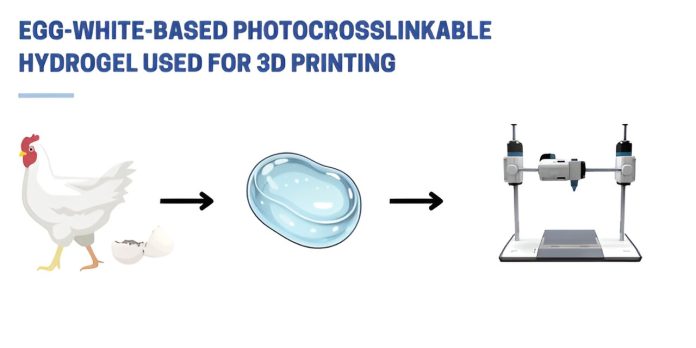
Scientists at the Terasaki Institute have developed a groundbreaking technology using egg whites to create a new type of bioink called egg white methacryloyl (EWMA).
This innovative bioink is described in a paper published in the journal Advanced Functional Materials.
Bioinks are crucial for 3D bioprinting, a process used to create artificial tissues.
These bioinks, made from natural or synthetic materials, support living cells by helping them stick, grow, and develop.
They are essential for making complex tissue structures used in medical research, drug testing, and organ transplantation.
The new EWMA bioink offers a unique combination of properties that address many challenges in tissue engineering.
The research team modified egg whites to create a photocrosslinkable bioink. This means the bioink can be hardened using light, making it suitable for bioprinting.
The EWMA bioink has several advantages for bioprinting applications. It contains many proteins, providing a nutrient-rich environment for cell growth.
It also has excellent biocompatibility and bioactivity, which are vital for successful tissue engineering.
One of the standout features of the EWMA bioink is its flexibility. Researchers can adjust the material’s properties to match the specific needs of different tissue structures, closely mimicking natural biological systems.
Additionally, EWMA bioinks have natural antiviral and antibacterial properties, offering extra protection against infections, which is especially valuable in medical applications.
The potential uses of this bioink extend far beyond the lab. EWMA bioinks could be used to create more accurate tissue models for drug testing, reducing the need for animal testing. In the long run, this technology could help develop functional tissue replacements for regenerative medicine.
Dr. Ali Khademhosseini, CEO of the Terasaki Institute and an expert in bioengineering, stated, “This innovative approach to creating bioinks from egg whites shows the immense potential of bio-inspired materials in tissue engineering.
By using readily available natural resources and enhancing them through clever chemical modifications, we’re opening new avenues for personalized regenerative medicine.
These breakthroughs are crucial in our quest to develop more effective and accessible solutions for organ failure, cardiovascular disease, and cancer treatments.”
As research continues, further improvements and new uses for EWMA bioink are expected. This breakthrough highlights the innovative drive in tissue engineering and the potential of bio-inspired materials to address complex medical challenges.
The development of EWMA bioink marks a significant step toward more effective and versatile bioprinting techniques, paving the way for advancements in tissue engineering and regenerative medicine.
If you care about medicine, please read studies that vitamin D could help lower the risk of autoimmune diseases, and drug for inflammation may stop spread of cancer.
For more health information, please see recent studies about which drug can harm your liver most, and results showing this drug can give your immune system a double boost against cancer



